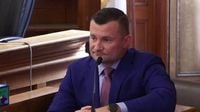In a gripping continuation of the Karen Read murder trial, Massachusetts State Police Sergeant Yuri Bukhenik took the witness stand on Thursday, May 8, 2025, in Dedham’s Norfolk Superior Court, shedding light on the investigation into the death of Read's boyfriend, Boston police officer John O’Keefe. The trial, presided over by Judge Beverly Cannone, is drawing considerable public interest as it explores the circumstances surrounding O’Keefe's tragic demise.
O’Keefe was found frozen to death outside a residence at 34 Fairview Road on January 29, 2022, following a night out. Read, 45, is charged with second-degree murder, with prosecutors alleging she struck O’Keefe with her Lexus SUV while driving under the influence. The defense contends that Read's vehicle never made contact with O’Keefe and suggests that others are responsible for his death.
During his testimony, Bukhenik detailed the early stages of the investigation, which began when he received a call about an unresponsive man in the snow at approximately 6:44 a.m. on that fateful day. He instructed Trooper Michael Proctor to contact the Canton police, but upon learning of O’Keefe's injuries, Bukhenik decided to respond personally. Arriving at the Canton Police station around 9:15 a.m., he was shown evidence collected at the scene, including a broken cocktail glass and a brown paper bag containing coagulated blood.
As Bukhenik and Proctor examined O’Keefe’s body at Good Samaritan Hospital later that day, they noted significant injuries: pooling blood under his head, swelling around his eyes, and multiple cuts and bruises. Bukhenik testified, "The location of the injuries, the types of injuries, the extent of the injuries and overall condition that his body was in would be very telling." He observed that O’Keefe’s missing sneaker indicated a possible vehicle strike, a theory that began to take shape based on the nature of the injuries.
Following their examination, Bukhenik and Proctor sought to interview the last person known to have seen O’Keefe—his girlfriend, Karen Read. They traveled to Read's parents' home, where they observed her Lexus SUV had a large piece of red taillight cover missing. Bukhenik noted, "I was interested in the vehicle she was operating," and indicated that the damage could be relevant to the investigation.
During the interrogation, Read stated that she had dropped O’Keefe off at the Fairview residence after a night of drinking at local bars, including C.F. McCarthy’s and the Waterfall Bar and Grille. She claimed she did not see him enter the house. Bukhenik recounted Read’s remarks about O’Keefe hitting his head two nights prior, which she described as a minor incident. However, when questioned about the injuries observed on O’Keefe, Read insisted she had not seen any injuries on him.
After the interview, Read's vehicle and cell phone were seized as part of the investigation. Bukhenik's testimony highlighted the meticulous nature of the evidence collection process, which included drying O’Keefe’s clothing laid out on butcher paper to preserve potential evidence.
In a twist during the trial, a digital forensics expert, Jessica Hyde, testified regarding Google searches made by Jennifer McCabe, a friend of the couple, on the day O’Keefe was found. Hyde confirmed that McCabe searched for the phrase "how long to die in cold" at 6:24 a.m., shortly after O’Keefe was discovered unconscious. This contradicted the defense's claim that the search occurred before O’Keefe was found. Hyde's analysis pointed to the search being made after the discovery, raising further questions about the timeline of events.
As the trial progresses, jurors are grappling with the complex interplay of evidence, witness statements, and the implications of the digital searches. Judge Cannone has instructed the jury to carefully consider the admissibility of statements made by Read during her interrogation, emphasizing the importance of determining whether those statements were made freely.
Prosecutors are working diligently to dismantle the defense's timeline, while defense attorneys argue that Read is a victim of circumstance, asserting that she was framed for O’Keefe's murder. The defense has pointed to alleged cover-ups involving law enforcement, claiming that O’Keefe was injured inside the home and subsequently left outside.
As the trial enters its next phase, the courtroom remains a focal point for those following the case, with many intrigued by the unfolding drama that has captivated public attention. The proceedings are expected to last several weeks, with the potential for further revelations as more witnesses take the stand.
The case has garnered significant media coverage, with various outlets providing live updates and analysis. The trial is seen as a pivotal moment not only for Read but also for the larger conversation surrounding accountability and justice in cases involving law enforcement personnel.
With the stakes high and emotions running deep, the Karen Read trial is poised to continue drawing attention as it unfolds in the coming weeks. As jurors weigh the evidence, the community watches closely, eager for answers in this tragic and complex case.



